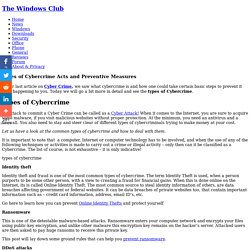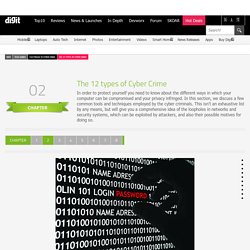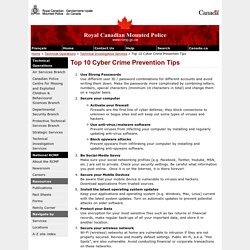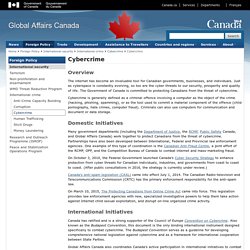

CYBER CRIME IN CANADA. 2 Ontario residents charged in Edmonton extortion investigation. Police in Edmonton have charged two people from Ontario with extortion after a local man was allegedly threatened through a text messaging app.

The Edmonton Police Service received a report in February that an Edmonton man was receiving threatening text messages from an unknown third party. The messages demanded money and threatened the man’s life if he didn’t pay up, police said in a media release Friday. Pictures of a firearm were also sent to the man. The messages also suggested the sender knew the man’s home address, police said. The EPS Cyber Crime Investigations Unit traced the messages and on March 19, Edmonton officers searched an address in Ancaster, Ont., with the assistance of the Hamilton Police Service.
Canadian small businesses ‘woefully outgunned’ in battle with cybercrime: experts. Almost a third of Canadian businesses unknowingly divulged sensitive information — including customer data — to phishing scams in 2017.

According to the first Canadian Internet Security Survey conducted by the Canadian Internet Registration Authority (CIRA), this can be traced to a large gap between cybersecurity awareness and personal protection. Man defrauded $3,500 through friend’s hacked Facebook account: OPP - Kingston. Posted January 7, 2019 11:15 pm Napanee OPP say a 60-year-old man has complained that he was tricked into giving away thousands of dollars after Facebook friend’s account was allegedly hacked.

On Dec. 31 Napanee OPP received a complaint from the victim, who said he was communicating with a Facebook friend, not knowing that the account had been hacked. The person behind the account allegedly convinced the man to put $3,500 into a bank account provided by the Facebook account. Police say the man was told that if he deposited that money into the account he would get $300,000 from the federal government — grant money the alleged scammer said was set aside for disabled workers. The man deposited the money before he learned he was being duped. Story continues below advertisement. Man defrauded $3,500 through friend’s hacked Facebook account: OPP - Kingston. Virtual ‘kidnapping’ scam aimed at female Chinese students hits Vancouver. A virtual kidnapping scam targeting female Chinese students has hit Vancouver.

Canadians at higher risk of hacks, thanks to their smart devices: report. Multiple “smart” devices launched in Canada in 2017, but a new report by Norton states that consumers affected by cyber-crime last year were largely adopters of smart home interfaces and emerging security features.

The report revealed that 10 million Canadians spent $1.8 billion dealing with the aftermath of being hacked in 2017, and the average cost per consumer totaled $69. WATCH: 2017 Tech Trends: An in-depth look at smart home speakers Kevin Haley, the director of product management and security response at Symantec, told Global News that while consumers are tech-savvier than ever before, having more devices — and sharing information across those several devices — inevitably means there will be more hacks. “That attack space is larger,” he said. Home. Cybercrime: an overview of incidents and issues in Canada.
Cybercrime is the biggest threat online: Communications Security Establishment. Cybercrime is the most significant threat to Canadians in 2019. Cybercrime Will Get Worse In 2019. Cybercrime Damages $6 Trillion by 2021. A look back at cybercrime in 2018. 11 ways to help protect yourself against cybercrime. Securing Your Computer. You should consider the following tips to ensure your computer and other devices (such as phones and tablets) are protected from possible cybercrime attacks: use a firewall to block unauthorised access,ensure your device’s operating system is up-to-date,use up-to-date anti-virus and anti-spyware software, use a pop-up advertising blocker on your internet browser, use strong passwords, and do not use the same password on different sites,secure your wireless network and be careful when using public wireless networks,use reputable websites and mobile applications, andavoid clicking on unexpected or unfamiliar links.

You may also wish to check whether your Internet Service Provider (ISP) is an iCode signatory. If you are concerned that you have fallen victim to cybercrime you should report it to the ACORN. The following resources on the Government’s Stay Smart Online website provide further information on securing your computer and software: Learn about cybercrime. Types of Cybercrime, Fraud, Acts and Preventive Measures. In our last article on Cyber Crime, we saw what cybercrime is and how one could take certain basic steps to prevent it from happening to you.

Today we will go a bit more in detail and see the types of Cybercrime. An attack to commit a Cyber Crime can be called as a Cyber Attack! When it comes to the Internet, you are sure to acquire some malware, if you visit malicious websites without proper protection. Cybercrime: YouTube Aggregate. Scammers The Rise Of Cyber Crime In Britain Documentary 2015. The 12 Types Of Cyber Crime. There are literally a dozen ways in which a cybercrime can be perpretrated, and you need to know what they are In order to protect yourself you need to know about the different ways in which your computer can be compromised and your privacy infringed.

In this section, we discuss a few common tools and techniques employed by the cyber criminals. This isn’t an exhaustive list by any means, but will give you a comprehensive idea of the loopholes in networks and security systems, which can be exploited by attackers, and also their possible motives for doing so. Cybercrime: Guardian News Aggregate.
Top 10 Cyber Crime Prevention Tips. Royal Canadian Mounted Police.

Cybercrime. Overview The internet has become an invaluable tool for Canadian governments, businesses, and individuals.

Cybercrime. A Brief History of Cyber Crime – Florida Tech Online. Our modern society demands a degree of connectivity between citizens, businesses, financial institutions and governments that must cross political and cultural boundaries. Digital technology provides this connectivity and gives its users many valuable benefits. But at the same time, it provides a rich environment for criminal activity, ranging from vandalism to stolen identity to theft of classified government information. Hacking is a term used to describe the activity of modifying a product or procedure to alter its normal function, or to fix a problem. The term purportedly originated in the 1960s, when it was used to describe the activities of certain MIT model train enthusiasts who modified the operation of their model trains. They discovered ways to change certain functions without re-engineering the entire device.
The malicious association with hacking became evident in the 1970s when early computerized phone systems became a target. The 16 Most Common Types of Cybercrime Acts. Cybercrime is any criminal activity that takes place in the cyberspace. One of the earliest and the most common types of cybercrime activity is hacking. It roughly started in the 1960s. It involves stealing identities and important information, violating privacy, and committing fraud, among others. According to the Identity Theft Resource Center, over 170 million personal records were exposed through 780 data security breaches in 2015.